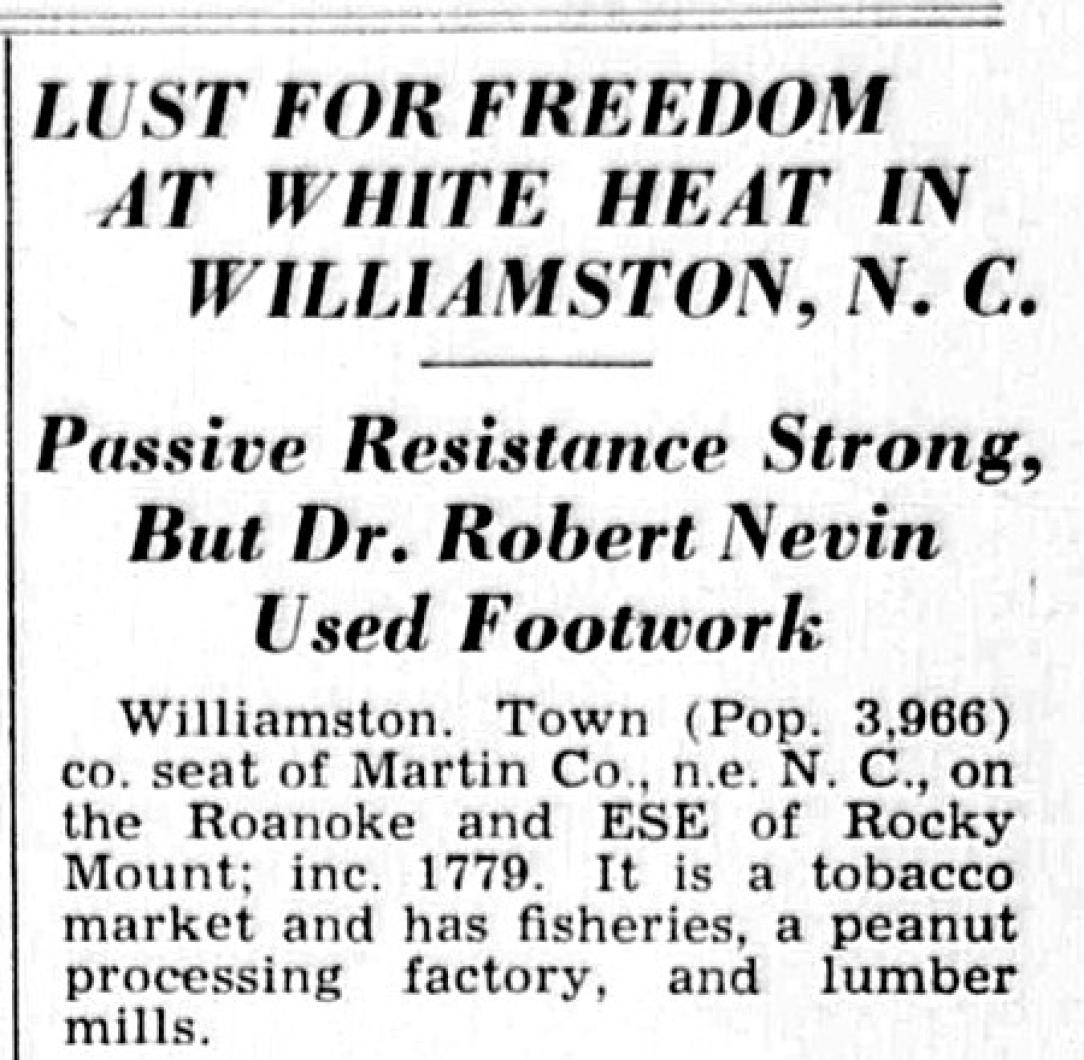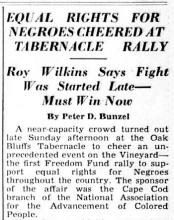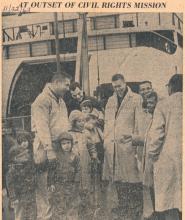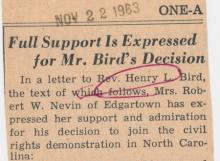Williamston. Town (Pop. 3,966) co, seat of martin Co., n.e. N. C., on the Roanoke and ESE of Rocky Mount; inc. 1779. It is a tobacco market and has fisheries, a peanut processing factory, and lumber mills.
This is what the Columbia Encyclopedia says of a place few Vineyarders had known about until the past few weeks. It is unlikely that any Islander of the present generation had ever visited Williamston until the journeys made recently by Rev. Henry L. Bird and Dr. Robert W. Nevin in the case referred to generally as that of civil rights, though it might as well be defined in terms of larger humanity or the freedom of mankind.
Dr. Nevin’s comments on his trip can be taken as a municipal report of the kind O. Henry wrote long ago concerning Nashville, but expressed in fact, not fiction.
When he was ready to begin his trip home, Dr. Nevin went to the station which is in enemy territory in Williamston. Two white bystanders heard him state his destination and began to talk of what they would do to him - one would take his head and the other would soften up his belly. They approached, ready for the assault, and the first man lunged at him.
Not a Passive Resister
This was where it became apparent that Dr. Nevin could not qualify for the passive resistance method which requires the complete control of any will or impulse to retaliate, and even of the natural reflexes involving self defense or counter-action.
Dr. Nevin, however, not only shifted his weight but could not resist tripping his assailant with his foot so that the man struck the wall and floor. He then removed his coat.
But the woman ticket-seller interfered in great distress lest she lose her job. A policeman standing nearby did nothing. Law and order were obviously suspended, but the woman’s interest in keeping her job made the station a sanctuary, and Dr. Nevin stayed in it until the gathering of more outbound passengers gave the protection of numbers. In no great length of time he had a seat on the bus and was leaving Williamston, N. C., the county seat of Martin Co., behind him.
His trip, by the time it ended, had occupied four days, and he had remained in Williamston from about 11 a.m. until 6:30 p. m. This was long enough to learn a great deal.
Departure from Boston was preceded by a rendezvous at Tremont Temple at 11 on Friday morning, Nov. 22. There turned out to be a group of six instead of the projected five; one was Rev. Ronald P. Prinn, who served as assistant rector of the Episcopal Parish on Martha’s Vineyard from 1959 to 1961. Two were women, a lay reader and a minister’s wife. The two others were ministers.
Taped for TV
A departure scene was taped for TV, since publicity is one of the weapons in the demonstrations directed by the NAACP and the Southern Christian Leadership Conference. But the car in which the journey was to be made turned out to be a Ford Falcon with two tires half flat; the tires could be fixed, and at Dr. Nevin’s insistence they were, but a distressing shimmy was to be endured. In lieu of making the trip, a minister had donated the car to the cause.
The driving was divided into shifts, so that there would be someone reasonably fresh at the wheel at all stages, particularly during the long night hours. With the singing of Onward Christian Soldiers and other hymns, the group settled in. There came a minor crisis when the entourage missed a turn into the proper route, and Dr. Nevin, despite cries of “We can’t do that!” managed a crossing of the center late, thus correcting the error.
“Oh, I’ve never felt so vagrant in my life!” exclaimed one woman passenger, and they began singing, “We’ve broken the law, we’ve broken the law...”
And, as Dr. Nevin puts it, they drove and drove and drove, and at about 11 the next morning, after thirty-six hours without sleep, they drew up in the county seat of Martin County.
They were expected, still without sleep, to go to a mass meeting and then to the homes of Negroes to proselyte those who were hanging back from the protest movement because of apprehension. This schedule would have stretched the number of sleepless hours to forty-eight, which to Dr. Nevin did not make sense. He insisted upon finding a place to shave and eat, and then returned to the car and slept.
Observations Dead Serious
The southward trip had its odd and amusing aspects, but what Dr. Nevin observed in Williamston was dead serious.
1. Northerners, he says, “have no comprehension of the fierce lust the Negroes have for freedom - it’s like opening the door of a furnace and feeling the white heat of it. This is a tremendous thing.”
2. And there are two camps at war. The places where he could go were carefully defined. There are no sidewalks for colored people - sidewalks are only for whites - and in walking where the Negroes go one must always be on guard against being run down or run off the road. Hostile whites will try.
3. There is no help from the police. One of the ministers with Dr. Nevin’s group - ironically, a man who had steeled himself to overcome great apprehension - had been out for a walk and came back in a dazed condition. The face of a boy companion had been plowed along a rough cement wall. A couple of hostile whites had taken them into a side street and roughed them up.
4. The Negro church serves as a nerve center and rallying place, with a drawing together in common cause, and an escalation of emotion. Food is always to be had there. The news is reported and assessed and discussed.
5. Passive resistance has a tremendous force. Negroes willing to become demonstrators are tested by passing between lines of their instructors who hit them, spit at them, abuse them, for they must learn not to strike back. If you can’t be passive, you can’t demonstrate.
Dr. Nevin went to a mass meeting at which adolescents were being taught passive resistance. If you do nothing, if you are completely passive, any man who kicks or punches you will feel he is kicking or punching a helpless person.
6. Dr. Nevin is impressed with the strength and intelligence of the Negro leaders. Men with the ability to go into such fields as science in the modern world but are denied because of their race and lack of opportunity, direct all their energies into leading their own group. Their force, purpose, and energy are such that they will not be held back.
In the face of their leadership, whites are angry, frightened and insecure, and are made more so by the coming of white people from the north who, to them, are “nigger lovers.” Why don’t they stay at home and take care of the Negro problem in Boston? The issue itself they do not see.
Operation Dialogue Next
7. But what do the demonstrations accomplish? The next step is known as Operation Dialogue, and taking the place of the confrontation represented in the demonstrations themselves, a single white man and a single Negro will go to talk, say, with a town business man. The communication between the groups which has been entirely lacking will be supplied in a dialogue, face to face, with a confrontation of the alternatives. And the alternatives are peace or violence. There is no turning back. The past has gone for good.
With this vivid in his awareness, informed by first hand observation - and by the incident of violence in the bus station - Dr. Nevin headed north to arrive in a New York city with a lightless Times Square, a New York in which even at a distance each person could tell what each other was thinking and feeling. The horrible tragedy of President Kennedy’s assassination had put in context not only the struggle for civil rights but the plight of the whole human condition.










Comments